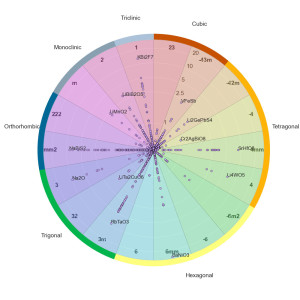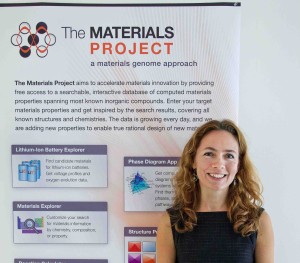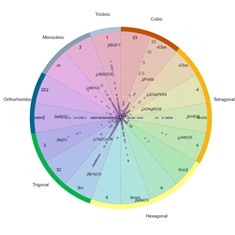
Graphical representation of piezoelectric constant dataset. Concentric circles indicate constant values of the maximum longitudinal piezoelectric modulus. Compounds are organized according to crystal system and point group symmetry.
Disturbing a material’s crystal lattice can create a charge imbalance that leads to a voltage across the material. This phenomena, called the “piezoelectric effect,” was first demonstrated in 1880 by Jacques and Pierre Curie in materials such as quartz, topaz and Rochelle salt. Today, piezoelectricity is recognized as a valuable property and the market for piezoelectric materials is rapidly expanding with applications that encompass a variety of technologies, ranging from medical imaging to sonar to energy harvesting.
Despite its rising technological importance, the piezoelectric effect has been measured in only a handful of materials, but this is about to change. Researchers at Berkeley Lab and the University of California (UC) Berkeley have developed a methodology that enabled them to compute piezoelectric constants for nearly 1,000 inorganic compounds.
“People know how to calculate piezoelectric tensors but now we’ve developed a robust workflow for these calculations, which provides an unprecedented scaling of methodology for testing materials,” says Kristin Persson, staff scientist at Berkeley Lab’s Materials Sciences Division and leader of the Materials Project, which provides open web-based access to computed information on known and predicted materials. “Not only does this provide new open-access data to the community, but also indicates what structures and elements might be important for developing novel materials with strong piezoelectric properties.”

Kristin Persson leads the Materials Project, which provides open web-based access to computed information on known and predicted materials. (Photo by Roy Kaltschmidt)
In the new high-throughput calculations using the computing resources at the National Energy Research Scientific Computing Center (NERSC), hundreds of structures can be computed simultaneously. Compared to conventional experimental measurements, which could take years to cover the same number of materials, the “computational characterization” quickly identifies promising inorganic compounds in the Materials Project database that have the possibility of exhibiting piezoelectric behavior.
Persson, along with Mark Asta, staff scientist at Berkeley Lab and professor in UC Berkeley’s Department of Materials Science and Engineering, are co-authors of a paper describing this research in the journal Scientific Data. The paper is titled “A database to enable discovery and design of piezoelectric materials.” The other authors are Maarten de Jong, Wei Chen and Henry Geerlings.
Certain structures of elements give rise to large piezoelectric responses: when subjected to a stress, they develop a stronger electric field. The larger the response – indicated by the tensor – the better the piezoelectric performance.
“The new database …will be invaluable for guiding the discovery of new candidate materials featuring enhanced performance, lower cost, and or more environmentally friendly constituents,” Asta says.
“We don’t collect experimental data – but we compare calculations with reported experimental piezoelectric constants,” says Persson. “For new materials that have not been measured before, it’s up to the community to test the data – by growing a film or a single crystal – and comparing with Materials Project computations.”
In 1910, Woldemar Voigt published the Textbook on Crystal Physics, defining the piezoelectric constants of 20 natural crystal classes. Now, the Materials Project has published tensor analyses that suggest completely new materials as potential piezoelectrics.
“The highest performing piezoelectric ceramics currently available contain high concentrations of lead, and significant efforts are aimed at identifying new lead-free compounds,” Asta says. “The new database is anticipated to greatly accelerate such materials discovery efforts.”
This research was funded by the Materials Project Center and made use of resources of the National Energy Research Scientific Computing Center (NERSC), supported by the Office of Basic Energy Sciences of the US Department of Energy.
# # #
Lawrence Berkeley National Laboratory addresses the world’s most urgent scientific challenges by advancing sustainable energy, protecting human health, creating new materials, and revealing the origin and fate of the universe. Founded in 1931, Berkeley Lab’s scientific expertise has been recognized with 13 Nobel prizes. The University of California manages Berkeley Lab for the U.S. Department of Energy’s Office of Science. For more, visit www.lbl.gov.
DOE’s Office of Science is the single largest supporter of basic research in the physical sciences in the United States, and is working to address some of the most pressing challenges of our time. For more information, please visit science.energy.gov.
